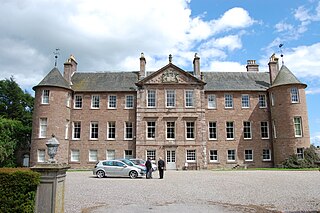
Brechin Castle is a castle in Brechin, Angus, Scotland. The castle was constructed in stone during the 13th century. Most of the current building dates to the early 18th century, when extensive reconstruction was carried out by architect Alexander Edward for James Maule, 4th Earl of Panmure, between approximately 1696 and 1709. The castle is a 37,748 square feet (3,506.9 m2) Category A listed building and the grounds are included in the Inventory of Gardens and Designed Landscapes in Scotland.

Dunrobin Castle is a stately home in Sutherland, in the Highland area of Scotland, as well as the family seat of the Earl of Sutherland and the Clan Sutherland. It is located one mile north of Golspie and approximately five miles south of Brora, overlooking the Dornoch Firth.

Lennoxlove House is a historic house set in woodlands half a mile south of Haddington in East Lothian, Scotland. The house comprises a 15th-century tower, originally known as Lethington Castle, and has been extended several times, principally in the 17th, 19th and 20th centuries. The house is protected as a category A listed building, and is described by Historic Scotland as "one of Scotland's most ancient and notable houses." The wooded estate is included on the Inventory of Gardens and Designed Landscapes in Scotland, the national listing of significant gardens.
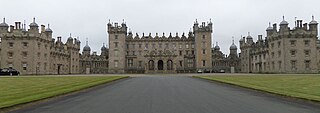
Floors Castle, in Roxburghshire, south-east Scotland, is the seat of the Duke of Roxburghe. Despite its name it is an estate house rather than a fortress. It was built in the 1720s by the architect William Adam for Duke John, possibly incorporating an earlier tower house. In the 19th century it was embellished with turrets and battlements, designed by William Playfair, for The 6th Duke of Roxburghe. Floors has the common 18th-century layout of a main block with two symmetrical service wings. Floors Castle stands by the bank of the River Tweed and overlooks the Cheviot Hills to the south.
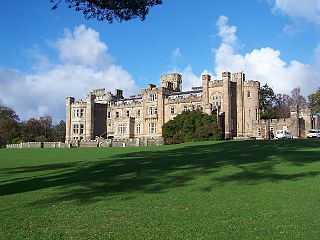
Castle Toward is a nineteenth-century country house in Argyll and Bute, Scotland.

Dunecht House is a stately home on the Dunecht estate in Aberdeenshire, Scotland. The house is protected as a category A listed building, and the grounds are included on the Inventory of Gardens and Designed Landscapes in Scotland, the national listing of significant gardens.
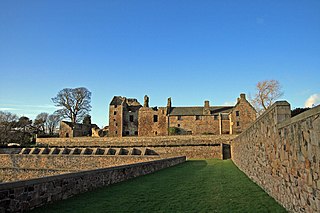
Aberdour Castle is in the village of Easter Aberdour, Fife, Scotland. Parts of the castle date from around 1200, making Aberdour one of the two oldest datable standing castles in Scotland, along with Castle Sween in Argyll, which was built at around the same time.

Craigcrook Castle is a well-preserved 6,701 square feet (622.5 m2) castle giving its name to the Craigcrook district of Edinburgh, about 3 miles (4.8 km) west of the centre of Edinburgh, Scotland. The castle is primarily of the 17th century, though with later additions. In the 19th century, it was the home of Francis Jeffrey, Lord Jeffrey, and became known for its literary gatherings. It is a category B listed building.

Ayton Castle is located to the east of Ayton in the Scottish Borders. It is 9 kilometres (5.6 mi) north-west of Berwick-upon-Tweed, in the former county of Berwickshire. Built around a medieval tower house, the present castle dates largely from the 19th century. Ayton Castle is the caput of the feudal barony of Ayton. The castle is protected as a category A listed building, and the grounds are included in the Inventory of Gardens and Designed Landscapes in Scotland, the national listing of significant parks and gardens.

Dalzell House is a historic house in Motherwell, North Lanarkshire, Scotland. It is located to the south of the town, on the north bank of the River Clyde. At its core is a 15th-century tower house, with extensive additions built during the 17th and 19th centuries. In the 1980s the house was restored and divided for sale as eighteen private apartments, while the surrounding Dalzell estate is now owned by North Lanarkshire Council. The house is protected as a Category A listed building, and the grounds are listed on the Inventory of Gardens and Designed Landscapes in Scotland.
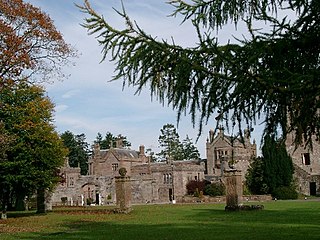
Hoddom Castle is a large tower house in Dumfries and Galloway, south Scotland. It is located by the River Annan, 4 kilometres (2.5 mi) south-west of Ecclefechan and the same distance north-west of Brydekirk in the parish of Cummertrees. The castle is protected as a category A listed building.

Stobo Castle is located at Stobo in the Scottish Borders, in the former county of Peeblesshire. The Manor of Stobo was originally owned by the Balfour family. It became the family seat of the Graham-Montgomery Baronets from 1767. The building of the present castle began in 1805 and was completed in 1811 under the supervision of architects Archibald and James Elliot. It is currently operated as a health spa. The house is protected as a category A listed building, while the grounds are included in the Inventory of Gardens and Designed Landscapes in Scotland, the national listing of significant parks and gardens.

Sorn Castle is located by the River Ayr just outside the village of Sorn in East Ayrshire, Scotland. The castle comprises a medieval tower house, which was extended over the years, and remodelled in the Scots Baronial style by David Bryce in the 1860s. The castle is protected as a category A listed building.

Oxenfoord Castle is a country house in Midlothian, Scotland. It is located 1 kilometre (0.62 mi) north of Pathhead, Midlothian, and 6 kilometres (3.7 mi) south-east of Dalkeith, above the Tyne Water. Originally a 16th-century tower house, the present castle is largely the result of major rebuilding in 1782, to designs by the architect Robert Adam. Oxenfoord was the seat of the Earl of Stair from 1840, and remains in private ownership. It is protected as a category A listed building, while the grounds are included in the Inventory of Gardens and Designed Landscapes in Scotland.

Ardgowan House, Castle & Gardens is a Privately owned late 18th-century mansion on the Firth of Clyde near Inverkip, Scotland. Ardgowan is located in Inverclyde, in the former county of Renfrewshire. The Ardgowan Estate has been held by the Stewart family since the early 15th century: towards the end of that century, their tower house Ardgowan Castle was built within the site of the previous Inverkip Castle fortress. The present house was erected in 1797 and completed in 1801 from designs by Cairncross. It is the seat of the Shaw Stewart baronets, currently Sir Ludovic Houston Shaw Stewart, 12th Baronet of Greenock and Blackhall.
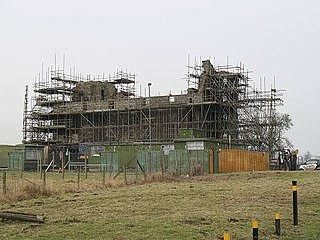
Duntarvie Castle is a ruined Scots Renaissance house in West Lothian, Scotland. It is located 1.5 kilometres (0.93 mi) north of Winchburgh and 9 kilometres (5.6 mi) east of Linlithgow, close to the M9 motorway. Constructed in the late 16th century, the building has been undergoing restoration since the 1990s. The house is protected as a category A listed building, and a scheduled monument.

Inchdrewer Castle is a 16th-century tower house in the parish of Banff, Aberdeenshire, in the north-east of Scotland. Situated on a slight rise 3.5 miles (5.6 km) south-west of Banff, it looks across to Banff Bay. Originally owned by the Currour family, it was purchased by the Ogilvies of Dunlugas in 1557 and became their main family seat. The Ogilvies were staunch Royalists, which resulted in the castle coming under attack from the Covenanters in 1640. George Ogilvy, 3rd Lord Banff was murdered in 1713 and his body hidden inside the castle, which was then set on fire. The castle came under siege again in 1746, during the Jacobite rising of 1745–46. At the start of the 19th century, following the death of the 8th Lord Banff, the property was inherited by the Abercromby of Birkenbog family, who leased it to a tenant. It became uninhabited after 1836 and the structure deteriorated.

Dalcross Castle is a restored 17th century tower house, about 1+1⁄2 miles southwest of Croy, Highland, Scotland, and about 7 miles northeast of Inverness. The castle stands on a ridge.

Birkwood Castle, also known as Birkwood House, is a Gothic country house situated in Lesmahagow, South Lanarkshire, Scotland. Built in the 18th century, it was greatly expanded by the McKirdy family. In 1920 it was purchased by the local authority for use as a hospital. Following closure of the hospital, attempts have been made to redevelop the building. The house is the subject for numerous ghostlore stories.
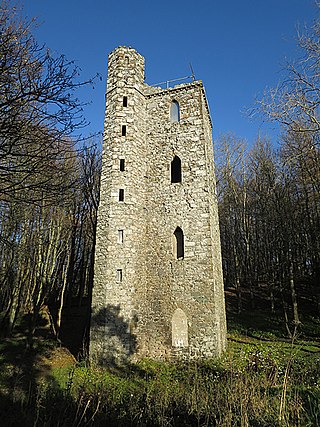
Binnhill Tower is a stone-built tower in the Gothic style, located in Kinfauns, Perth and Kinross, Scotland. A Category B listed structure, it stands on Binn Hill, in the centre of Binn Wood, about 0.4 miles (0.64 km) east of Kinfauns Castle. It was designed in 1839 by local architect William Mackenzie, to an order by Francis Gray, 14th Lord Gray.





















